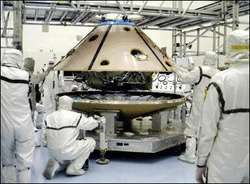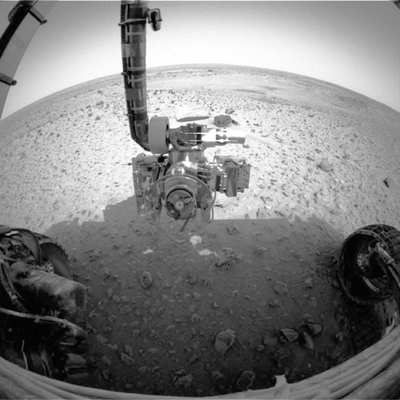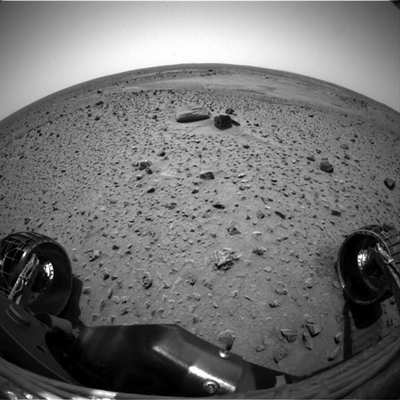Spirit, Opportunity still making progress, despite some
setbacks
 As winter approaches on Mars, NASA's
Opportunity rover continues to inch deeper into the stadium-sized
crater dubbed "Endurance." On the other side of the planet, the
Spirit rover found an intriguing patch of rock outcrop while
preparing to climb up the "Columbia Hills" backward. This unusual
approach to driving is part of a creative plan to accommodate
Spirit's aging front wheel.
As winter approaches on Mars, NASA's
Opportunity rover continues to inch deeper into the stadium-sized
crater dubbed "Endurance." On the other side of the planet, the
Spirit rover found an intriguing patch of rock outcrop while
preparing to climb up the "Columbia Hills" backward. This unusual
approach to driving is part of a creative plan to accommodate
Spirit's aging front wheel.
Spirit, with an odometer reading of over 3.5 kilometers (2.2
miles), has already traveled six times its designed capacity. Its
right front wheel has been experiencing increased internal
resistance, and recent efforts to mitigate the problem by
redistributing the wheel's lubricant through rest and heating have
been only partially successful.

To cope with the condition, rover planners have devised a
roundabout strategy. They will drive the rover backward on five
wheels, rotating the sixth wheel only sparingly to ensure its
availability for demanding terrain. "Driving may take us a little
bit longer because it is like dragging an anchor," said Joe Melko,
a rover engineer at NASA's Jet Propulsion Laboratory, Pasadena,
Calif. "However, this approach will allow us to continue doing
science much longer than we ever thought possible."
On Thursday, July 15, Spirit successfully drove 8 meters (26
feet) north along the base of the Columbia Hills backward, dragging
its faulty wheel. The wheel was activated about 10 percent of the
time to surmount obstacles and to pull the rover out of trenches
dug by the immobile wheel.
Along the way, Spirit drove over what scientists had been hoping
to find in the hills -- a slab of rock outcrop that may represent
some of the oldest rocks observed in the mission so far. Spirit
will continue to drive north, where it likely will encounter more
outcrop. Ultimately, the rover will drive east and hike up the
hills backward using all six wheels.
"A few months ago, we weren't sure if we'd make it to the hills,
and now here we are preparing to drive up into them," said Dr. Matt
Golombek, a rover science-team member from JPL. "It's very
exciting."
For the past month, the Spirit rover has been parked near
several hematite-containing rocks, including "Pot of Gold,"
conducting science studies and undergoing a long-distance "tuneup"
for its right front wheel.
Driving with the wheel disabled means that corrections might
have to be made to the rover's steering if it veers off its planned
path. This limits Spirit's accuracy, but rover planners working at
JPL's rover test facility have come up with some creative commands
that allow the rover to auto-correct itself to a limited
degree.

As Spirit prepares to climb upward, Opportunity is rolling
downward. Probing increasingly deep layers of bedrock lining the
walls of Endurance Crater at Meridiani Planum, the rover has
observed a puzzling increase in the amount of chlorine. Data from
Opportunity's alpha particle X-ray spectrometer show that chlorine
is the only element that dramatically rises with deepening layers,
leaving scientists to wonder how it got there. "We do not know yet
which element is bound to the chlorine," said Dr. Jutta Zipfel, a
rover science-team member from the Max Planck Institute for
Chemistry, Mainz, Germany.
Opportunity will roll down even farther into the crater in the
next few days to see if this trend continues. It also will
investigate a row of sharp, teeth-like features dubbed "Razorback,"
which may have formed when fluid flowed through cracks, depositing
hard minerals. Scientists hope the new data will help put together
the pieces of Meridiani's mysterious and watery past. "Razorback
may tell us more about the history of water at Endurance Crater,"
said Dr. Jack Farmer, a rover science-team member from Arizona
State University, Tempe.

Rover planners are also preparing for the coming Martian winter,
which peaks in mid-September. Dwindling daily sunshine means
the rovers will have less solar power and take longer to recharge.
Periods of rest and "deep sleep" will allow the rovers to keep
working through the winter at lower activity levels. Orienting the
rovers' solar panels toward the north will also elevate power
supplies. "The rovers might work a little bit more every day, or a
little bit more every other day. We will see how things go and
remain flexible," said Jim Erickson, project manager for the Mars
Exploration Rover mission at JPL.
 ANN's Daily Aero-Term (04.20.24): Light Gun
ANN's Daily Aero-Term (04.20.24): Light Gun Aero-News: Quote of the Day (04.20.24)
Aero-News: Quote of the Day (04.20.24) ANN's Daily Aero-Linx (04.21.24)
ANN's Daily Aero-Linx (04.21.24) Aero-News: Quote of the Day (04.21.24)
Aero-News: Quote of the Day (04.21.24) ANN's Daily Aero-Term (04.21.24): Aircraft Conflict
ANN's Daily Aero-Term (04.21.24): Aircraft Conflict






